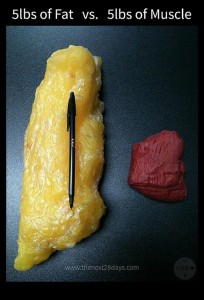In this, the final installment in our four-part series on muscle and fat myths, we’ll set the facts straight on muscle weighing more than fat. It is a misconception that you’ve likely heard or read before–maybe even here on these very blog pages. It’s never our intention to mislead, but the reason this myth gets passed on and repeated so often is that it is almost true–clearing up the inaccuracy lies in comparing volume rather than actual weight.
What Weighs More: a Pound of Feathers or a Pound of Iron?
Ever come up against this brain teaser? The initial response from anyone who doesn’t take about 3 seconds to think it through is that feathers are lighter than iron, but a pound is a pound, no matter what you’re weighing. According to Shape magazine, it’s simply that muscle tissue is denser than bulky fat tissue, so a pound of fat takes up more space than a pound of muscle. To be fair, if you’re comparing the same mass amount of muscle and fat, yes, the muscle will weigh more. However, comparing the volume of a pound of muscle to a pound of fat, it’s not like comparing apples and oranges. It’s more like grapefruits and tangerines. American Council on Exercise Professional Trainer Jason Greenspan says a pound of fat is grapefruit-sized and a pound of muscle is approximately as big as a tangerine.
The Type of Tissue Makes a Difference, Too

Muscles are active even when you aren’t, so they’ll still be burning fat and calories long after you’re done working out.
Muscle and fat tissue are almost opposites when it comes to tissue type. While muscle is an active tissue that burns more fuel–i.e.: calories and fat–than other types of tissue, fat is considered adipose tissue, according to Science Daily. Even within adipose tissues, there are sub-types of fat, but the Encyclopedia of Sports Medicine and Science says fat tissue is less active metabolically speaking, so it doesn’t matter a whole lot whether you have mostly white fat or brown fat. If you are carrying more fat than muscle, most of that tissue is sitting there doing pretty much nothing for your metabolism.
The Scale is a Liar

Though you can’t necessarily trust the scale to tell you how lean you are, the tape measure will never lie to you.
These facts about fat and muscle mean you can’t count on the scale to accurately measure how you’re doing on your weight loss goal, especially if you are following the best weight loss advice which is to incorporate cardio and resistance training with diet modification. The exercise will build muscle while the entire program will simultaneously help reduce fat, resulting in the number on the scale staying at the starting point for awhile or even going up a bit, even as you’re seeing yourself slimming down. Many times, the pounds you see on the scale could undermine your confidence and resolve, so it’s best to track your progress in other ways. Use a tape measure to assess your problem areas such as your waist, hips, and thighs. Pay close attention to how your clothes fit, and don’t be afraid to look in the mirror–naked. Once you start seeing more muscle definition and less jiggly bits, you might say “goodbye” to the scale forever.

